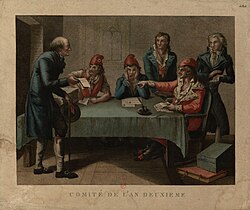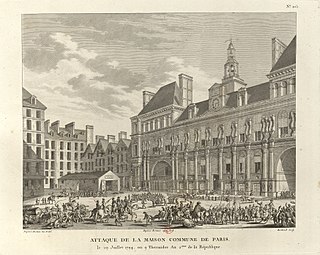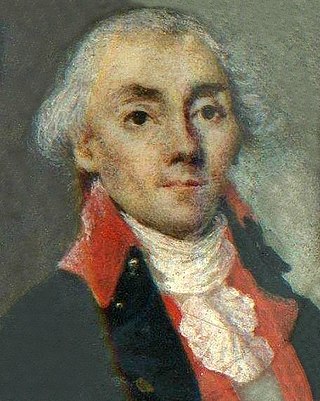
The revolutionary sections of Paris were subdivisions of Paris during the French Revolution. They first arose in 1790 and were suppressed in 1795.

The revolutionary sections of Paris were subdivisions of Paris during the French Revolution. They first arose in 1790 and were suppressed in 1795.
At the time of the Revolution, Paris measured 3440 hectares, compared to the 7800 hectares of today. It was bounded to the west by the place de l'Étoile, to the east by the cimetière du Père-Lachaise, to the north by place de Clichy, and to the south by the cimetière du Montparnasse. Under the Ancien Régime, the city had been divided into 21 'quartiers'.
In 1789, with a view to elections to the Estates-General, it was instead divided provisionally into 60 districts. By a decree of 21 May 1790, sanctioned by King Louis XVI on 27 June, the National Constituent Assembly created 48 'sections' ('section' then meaning a territorial and administrative division) to replace the 60 districts. Each section was made up of a civil committee, a revolutionary committee and an armed force.
After the Thermidorian Reaction on 27 July 1794, the sections still played an important role in suppressing the popular uprisings. In 1795, however, they were suppressed by the French Directory, which renamed the areas covered by sections as divisions, then quartiers.
Each section was headed by a civil committee of 16 members (elected by active citizens in the area covered by the section), the juges de paix (judges) and members intended to act as intermediaries between their section and the Paris Commune. From 1792 onwards, the sections occupied themselves permanently with political questions. On 25 July 1792, the Parisians decided to abolish the distinction between active citizens and passive citizens. As a result, the sections' assemblies sat permanently and became the political organ of the sans-culottes. After the Brunswick Manifesto they demanded the deposition of the king, by 47 sections to 48. [1]
On 9 August 1792 each section delegated commissioners elected by the active and passive citizens, as a replacement for the 'municipalité' of Paris. There were 52 of these commissioners in total (including Jacques-René Hébert, Pierre-Gaspard Chaumette and François-Xavier Audouin) and they triggered the events of 10 August 1792, putting an end to the monarchy and giving rise to the 'Revolutionary Commune' of Paris.
Set up by a law of 21 March 1793, the initial task of the sections' revolutionary committees was surveillance on foreigners without interfering in the lives of French citizens. Their activities towards that end (often going beyond the limits the law of 21 March had placed on them) were enabled by the Law of Suspects of 17 September 1793. They also had the power to make lists and issue arrest warrants. They also had the right to deliver citizenship certificates, all in establishing a direct correspondence with the Committee of General Security.
Paris's armed force was headed by a commander in chief and divided into 6 legions, each legion made up of troops from eight sections. The troops of each section had their own commander in chief, second in command and adjutant-major. The companies were made up of 120 to 130 men, being bigger or smaller according to their section's population. A company was commanded by a captain, a lieutenant and two 'sous-lieutenants'. Each section also had a company of artillery (60 men and 2 cannon each). In the Thermidorian Reaction of 27 July 1794, during the fall of Maximilien Robespierre, 18 companies had been sent to the front by order of Lazare Carnot. Of the 30 remaining companies, three were used to keep order – at the National Convention, the Arsenal, and the Temple. Seventeen remaining companies replied to the Commune's appeal during the night of 27–28 July 1794.

The Society of the Friends of the Constitution, renamed the Society of the Jacobins, Friends of Freedom and Equality after 1792 and commonly known as the Jacobin Club or simply the Jacobins, was the most influential political club during the French Revolution of 1789. The period of its political ascendancy includes the Reign of Terror, during which well over 10,000 people were put on trial and executed in France, many for political crimes.

The Society of the Friends of the Rights of Man and of the Citizen, mainly known as Cordeliers Club, was a populist political club during the French Revolution from 1790 to 1794, when the Reign of Terror ended and the Thermidorian Reaction began.

The National Convention was the constituent assembly of the Kingdom of France for one day and the French First Republic for its first three years during the French Revolution, following the two-year National Constituent Assembly and the one-year Legislative Assembly. Created after the great insurrection of 10 August 1792, it was the first French government organized as a republic, abandoning the monarchy altogether. The Convention sat as a single-chamber assembly from 20 September 1792 to 26 October 1795.

The sans-culottes were the common people of the lower classes in late 18th-century France, a great many of whom became radical and militant partisans of the French Revolution in response to their poor quality of life under the Ancien Régime. The word sans-culotte, which is opposed to "aristocrat", seems to have been used for the first time on 28 February 1791 by Jean-Bernard Gauthier de Murnan in a derogatory sense, speaking about a "sans-culottes army". The word came into vogue during the demonstration of 20 June 1792.
In the historiography of the French Revolution, the Thermidorian Reaction is the common term for the period between the ousting of Maximilien Robespierre on 9 Thermidor II, or 27 July 1794, and the inauguration of the French Directory on 2 November 1795.

Jean-Lambert Tallien was a French politician of the revolutionary period. Though initially an active agent of the Reign of Terror, he eventually clashed with its leader, Maximilien Robespierre, and is best known as one of the key figures of the Thermidorian Reaction that led to the fall of Robespierre and the end of the Terror.

Jean-Baptiste Carrier was a French Revolutionary and politician most notable for his actions in the War in the Vendée during the Reign of Terror. While under orders to suppress a Royalist counter-revolution, he commanded the execution of 4,000 civilians, mainly priests, women and children in Nantes, some by drowning in the river Loire, which Carrier described as "the National Bathtub." After the fall of the Robespierre government, Carrier was tried for war crimes by the Revolutionary Tribunal, found guilty, and executed.
This glossary of the French Revolution generally does not explicate names of individual people or their political associations; those can be found in List of people associated with the French Revolution.

The Paris Commune during the French Revolution was the government of Paris from 1789 until 1795. Established in the Hôtel de Ville just after the storming of the Bastille, it consisted of 144 delegates elected by the 60 divisions of the city. Before its formal establishment, there had been much popular discontent on the streets of Paris over who represented the true Commune, and who had the right to rule the Parisian people. The first mayor was Jean Sylvain Bailly, a relatively moderate Feuillant who supported constitutional monarchy. He was succeeded in November 1791 by Pétion de Villeneuve after Bailly's unpopular use of the National Guard to disperse a riotous assembly in the Champ de Mars.

The National Guard is a French military, gendarmerie, and police reserve force, active in its current form since 2016 but originally founded in 1789 during the French Revolution.

The Constitution of 1793, also known as the Constitution of the Year I or the Montagnard Constitution, was the second constitution ratified for use during the French Revolution under the First Republic. Designed by the Montagnards, principally Maximilien Robespierre and Louis Saint-Just, it was intended to replace the constitutional monarchy of 1791 and the Girondin constitutional project. With sweeping plans for democratization and wealth redistribution, the new document promised a significant departure from the relatively moderate goals of the Revolution in previous years.

The Committee of General Security was a parliamentary committee of the French National Convention which acted as police agency during the French Revolution. Along with the Committee of Public Safety it oversaw the Reign of Terror. The Committee of General Security supervised the local police committees in charge of investigating reports of treason, and was one of the agencies with authority to refer suspects to the Revolutionary Tribunal for trial and possible execution by guillotine.

The Revolutionary Tribunal was a court instituted by the National Convention during the French Revolution for the trial of political offenders. It eventually became one of the most powerful engines of the Reign of Terror.

Claude François Chauveau-Lagarde (1756–1841) was a French lawyer who came into the public spotlight in the early stages of the French Revolution. He defended many notable cases during the Reign of Terror, including that of Marie Antoinette.

Antoine-François Momoro was a French printer, bookseller and politician during the French Revolution. An important figure in the Cordeliers club and in Hébertisme, he is the originator of the phrase ″Unité, Indivisibilité de la République; Liberté, égalité, fraternité ou la mort″, one of the mottoes of the French Republic.

Jean-Jacques Bréard was born into a family of a navy inspectors. He moved to France as a young boy in 1758. His first involvement in politics included organizing elections to the Estates General in Marennes and a short stint as mayor of Marennes from January 1790 through July 1790. He also served as administrator of the département of Charente-Inférieure for the district of Marennes, beginning in June 1790. In November 1790, he was elected vice president of the administration. Bréard served on the National Assembly as a representative of Charente- Inférieure and was elected as a deputy to the National Convention, once again representing Charente- Inférieure. He served briefly as President of the National Convention in February 1793. More importantly, Bréard served on the Committee of General Security from October 1792 to January 1793, as well as the Committee of Public Safety from April 1793 to June 1793, July 1794 to December 1794, and January 1795 to May 1795.

Pierre Louis Bentabole was a revolutionary Frenchman, born in Landau Haut Rhin on 4 June 1756 and died in Paris on 22 April 1798. As lawyer, he presided practiced in the district of Hagenau and Saverne; he was deputy of the Bas-Rhin to the National Convention on 4 September 1792. He voted to execute Louis XVI. On 6 October 1794, he was appointed to the Committee of Public Safety.